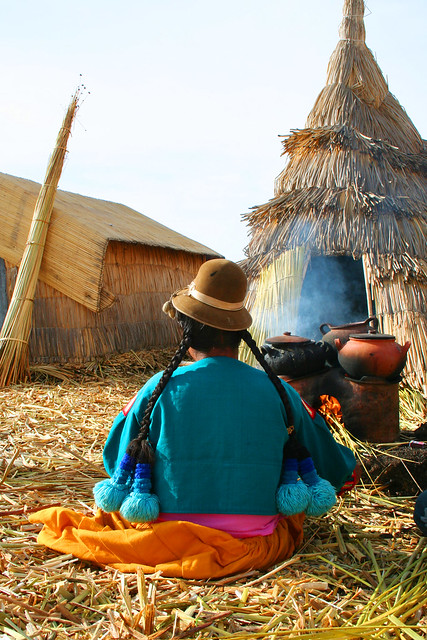
photo: flickr
Woman cooking in the Uros Island, Lake Titicaca, Peru.
The Uros are a pre-Incan people who live on forty-two self-fashioned floating islands in Lake Titicaca Puno, Peru and Bolivia. They form three main groups: Uru-Chipayas, Uru-Muratos and the Uru-Iruitos. The latter are still located on the Bolivian side of Lake Titicaca and Desaguadero River.
The Uros use bundles of dried totora reeds to make reed boats (balsas mats), and to make the islands themselves.
The Uros islands at 3810 meters above sea level are just five kilometers west from Puno port. Around 2,000 descendants of the Uros were counted in the 1997 census, although only a few hundred still live on and maintain the islands; most have moved to the mainland. The Uros also bury their dead on the mainland in special cemeteries.
The Uros do not reject modern technology: some boats have motors, some houses have solar panels to run appliances such as televisions, and the main island is home to an Uros-run FM radio station, which plays music for several hours a day.

photo: wikipedia
The Uros descend from a millennial town that according to legends are "pukinas" who speak Uro or Pukina and that believe they are the owners of the lake and water. Uros used to say that they have black blood because they did not feel the cold. Also they call themselves "Lupihaques" (Sons of The Sun).
The purpose of the island settlements was originally defensive, and if a threat arose they could be moved. The largest island retains a watchtower almost entirely constructed of reeds.
The Uros traded with the Aymara tribe on the mainland, interbreeding with them and eventually abandoning the Uro language for that of the Aymara. About 500 years ago they lost their original language. When conquered by the Inca empire, they had to pay taxes to them, and often were made slaves.
The larger islands house about ten families, while smaller ones, only about thirty meters wide, house only two or three.
The islets are made of totora reeds, which grow in the lake. The dense roots that the plants develop and interweave form a natural layer called Khili (about one to two meters thick) that support the islands. They are anchored with ropes attached to sticks driven into the bottom of the lake. The reeds at the bottoms of the islands rot away fairly quickly, so new reeds are added to the top constantly, about every three months; this is what it makes exciting for tourists when walking on the island. This is especially important in the rainy season when the reeds rot much faster. The islands last about thirty years.
Each step on an island sinks about 2-4" depending on the density of the ground underfoot. As the reeds dry, they break up more and more as they are walked upon. As the reed breaks up and moisture gets to it, it rots, and a new layer has to be added to it. It is a lot of work to maintain the islands. Because the people living there are so infiltrated with tourists now, they have less time to maintain everything, so they have to work even harder in order to keep up with the tourists and with the maintenance of their island. Tourism provides financial opportunities for the natives, while simultaneously challenging their traditional lifestyle.

photo: wikipedia
Uros' Food, Diet, and "Agriculture"
Much of the Uros' diet and medicine also revolve around these totora reeds. When a reed is pulled, the white bottom is often eaten for iodine. This prevents goiter. This white part of the reed is called the chullo (Aymara ). Like the Andean people of Peru rely on the Coca Leaf for relief from a harsh climate and hunger, the Uros rely on the Totora reeds in the same way. When in pain, the reed is wrapped around the place in pain to absorb it. Also if it is hot outside, they roll the white part of the reed in their hands and split it open, placing the reed on their forehead. In this stage, it is very cool to the touch. The white part of the reed is also used to help ease alcohol-related hangovers. It is a primary source of food. They also make a reed flower tea.
Drying fish in the sun
Local residents fish ispi, carachi and catfish. Trout was introduced to the lake from Canada in 1940, and kingfish was introduced from Argentina. Uros also hunt birds such as seagulls, ducks and flamingos, and graze their cattle on the islets. They also run crafts stalls aimed at the numerous tourists who land on ten of the islands each year. They barter totora reeds on the mainland in Puno to get products they need, such as quinoa and other foods.

Grinding corn
Food is cooked with fires placed on piles of stones. To relieve themselves, tiny 'outhouse' islands are near the main islands. The ground root absorbs the waste.
source: wikipedia